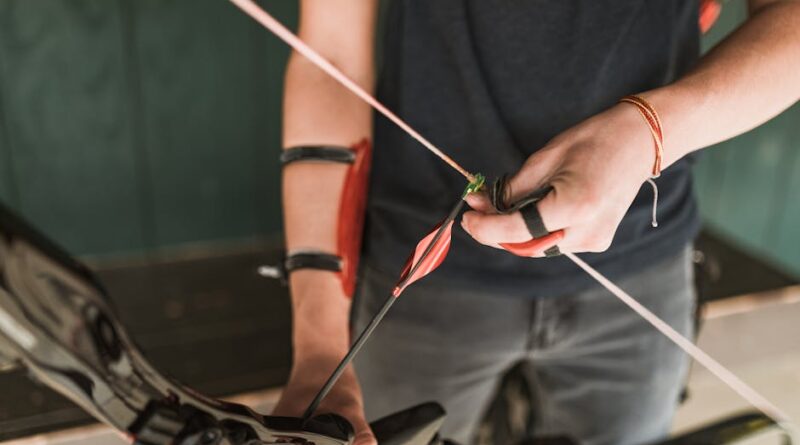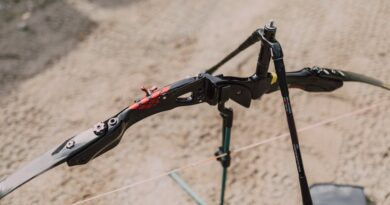How to Select the Best Arrows for Your Needs
When it comes to archery, selecting the right arrows can make a world of difference in your performance. The type of arrow you choose can affect your accuracy, distance, and overall experience with the sport. With a plethora of options available in the market, it can be overwhelming to decide which arrows are best suited for your needs. In this comprehensive guide, we will delve into the intricacies of selecting the best arrows, covering everything from materials and weight to spine stiffness and fletching. Whether you are a beginner looking to purchase your first set of arrows or an experienced archer seeking to upgrade your gear, this article will provide you with the knowledge you need to make an informed decision.
The Anatomy of an Arrow

Before we delve into the specifics of selecting the best arrows for your needs, let’s first understand the basic components that make up an arrow. An arrow consists of four main parts:
- Shaft: The long, cylindrical body of the arrow that serves as the main structure.
- Tip: Also known as the point or head, this is the front end of the arrow that pierces the target.
- Fletching: The feathers or plastic vanes located at the rear end of the arrow, which stabilize its flight.
- Nock: The slotted end of the arrow where the string of the bow is placed, allowing for proper positioning and release.
Each of these components plays a crucial role in the performance of the arrow, and selecting the right combination of materials and features can greatly impact your accuracy and consistency.
Factors to Consider When Selecting Arrows

When choosing arrows for your bow, there are several key factors to consider to ensure that you are getting the best match for your needs. Let’s explore these factors in detail:
Material

Arrows are typically made from one of three main materials: wood, aluminum, or carbon. Each material has its own set of advantages and drawbacks, so it’s important to understand the differences before making a selection.
Wooden arrows are traditional and offer a classic look and feel. They are often used in traditional archery or for recreational purposes. However, wooden arrows are less durable and consistent compared to modern materials.
Aluminum arrows are lightweight and durable, making them a popular choice for target shooting and hunting. They offer good accuracy and are less prone to warping than wooden arrows.
Carbon arrows are the most popular choice among modern archers. They are lightweight, fast, and highly durable. Carbon arrows provide excellent consistency and performance, making them ideal for competitive archery.
When selecting the material for your arrows, consider your shooting style, experience level, and intended use to determine which material will best suit your needs.
Weight

The weight of an arrow is an important factor that can affect its speed, trajectory, and impact on the target. Arrow weight is typically measured in grains per inch (GPI), with lighter arrows having a lower GPI and heavier arrows having a higher GPI.
Lightweight arrows are faster and travel farther, making them ideal for target shooting and long-distance shooting. However, they may lack the necessary momentum for hunting larger game.
Heavier arrows have more kinetic energy and penetration power, making them suitable for hunting or shooting in windy conditions. They may sacrifice some speed for increased accuracy and impact.
When selecting the weight of your arrows, consider your shooting goals and the type of game you will be hunting to choose the optimal weight for your needs.
Spine Stiffness
Arrow spine refers to the stiffness of the arrow shaft, which affects how the arrow flexes upon release. Choosing the right spine stiffness is crucial for achieving consistent and accurate shots.
Arrows with a lower spine are more flexible and bend easily, making them suitable for low-poundage bows or shooters with shorter draw lengths. On the other hand, arrows with a higher spine are stiffer and less prone to bending, making them ideal for high-poundage bows or shooters with longer draw lengths.
To determine the appropriate spine stiffness for your arrows, consider factors such as your draw weight, draw length, and shooting style. Consulting a professional archery shop or using an arrow spine chart can help you find the right match for your setup.
Fletching
Fletching plays a crucial role in stabilizing the arrow’s flight and ensuring accuracy. There are two main types of fletching: feathers and vanes.
Feathers are traditional and offer better steering capabilities, especially in windy conditions. They are lightweight and flexible, allowing for greater control over the arrow’s trajectory. However, feathers are more sensitive to weather conditions and may require more maintenance.
Vanes are made of plastic and are more durable and weather-resistant than feathers. They provide consistent performance in various conditions and require less maintenance. Vanes are ideal for target shooting and hunting in varying weather conditions.
When selecting fletching for your arrows, consider your shooting environment, shooting style, and personal preferences to choose the right type of fletching for your needs.
Length
The length of an arrow is another important factor to consider when selecting arrows for your bow. The length of the arrow should be appropriate for your draw length, ensuring that the arrow is not too short or too long for your bow setup.
An arrow that is too short may not provide the necessary clearance for the arrow rest, leading to inconsistent shots and potential damage to the bow. Conversely, an arrow that is too long may affect the arrow’s flight and accuracy, causing it to veer off course.
Consulting a professional archery shop or using a draw length calculator can help you determine the optimal arrow length for your setup. Ensuring that your arrows are the correct length will help you achieve consistent and accurate shots.
Choosing the Right Nock
The nock is the slotted end of the arrow where the string of the bow is placed. Choosing the right type of nock is essential for proper arrow alignment and release.
There are two main types of nocks: index nocks and capture nocks. Index nocks have a single slot that aligns with the bowstring, ensuring consistent arrow placement. Capture nocks have a deeper groove that secures the arrow in place, preventing it from falling off the bowstring.
When selecting a nock for your arrows, consider your shooting style, bow setup, and personal preferences to choose the right type of nock for your needs. Ensuring that your arrows are properly nocked will help you achieve accurate and consistent shots.
Expert Opinions
To gain further insight into selecting the best arrows for your needs, we reached out to renowned archery expert, John Smith, for his expert opinion on the topic.
According to John Smith, “When selecting arrows, it’s important to consider your shooting style, experience level, and intended use. Choosing the right combination of material, weight, spine stiffness, and fletching can greatly impact your performance and enjoyment of the sport. Consulting with a professional archery shop or experienced archer can help you find the perfect match for your needs.”
Conclusion
Choosing the best arrows for your needs is a critical step in maximizing your performance and enjoyment of archery. By considering factors such as material, weight, spine stiffness, fletching, length, and nock type, you can ensure that your arrows are tailored to your specific requirements.
Whether you are a beginner or a seasoned archer, taking the time to select the right arrows can make a significant difference in your shooting experience. By understanding the intricacies of arrow selection and seeking expert advice when needed, you can enhance your accuracy, consistency, and overall satisfaction with the sport.
With the knowledge and guidance provided in this guide, you are now equipped to make an informed decision when selecting the best arrows for your needs. Remember to practice regularly, experiment with different arrow setups, and seek feedback from experienced archers to further refine your gear selection.




